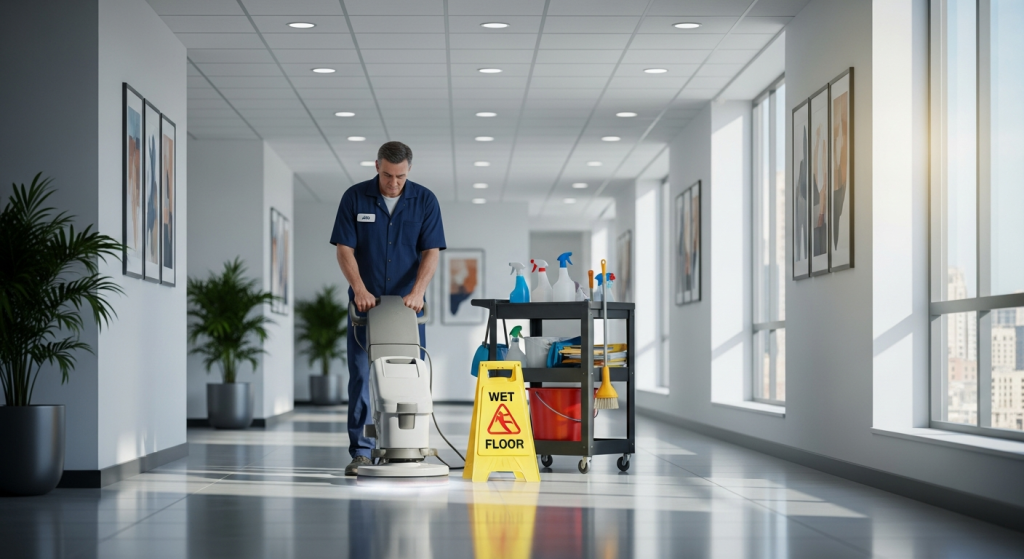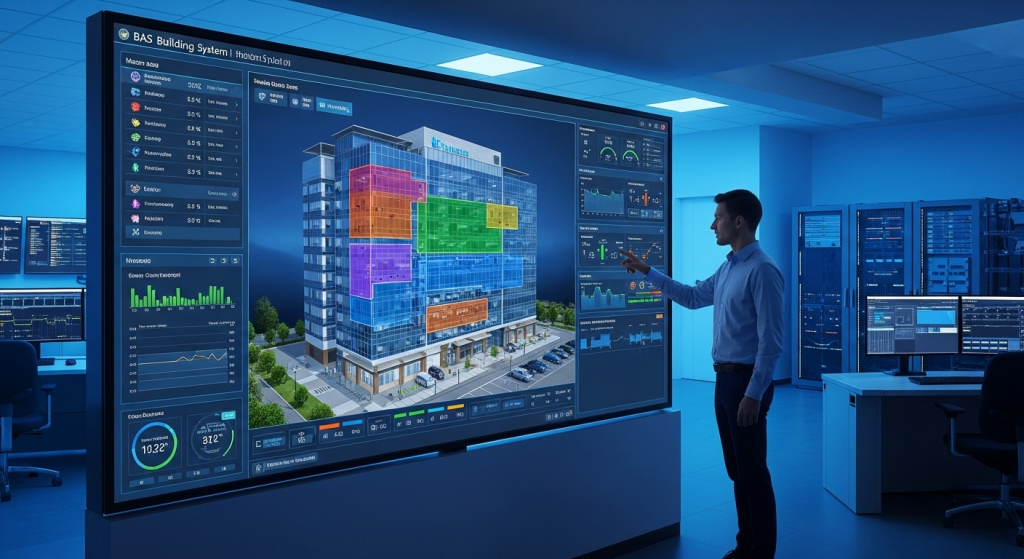Building control systems and building automation systems (BAS) are reshaping operational efficiency. Ever wondered how modern buildings stay so efficient and comfortable? A Building Automation System (BAS) could be the answer. This smart, centralized system monitors and controls a building’s key operations, from HVAC to lighting, all while optimizing energy use and creating a safe, comfortable space for occupants. By gathering and analyzing data in real-time, a BAS makes precise adjustments to ensure everything runs smoothly. Curious about how it works and what it could do for your facility? Keep reading to discover its powerful benefits.
What Are Building Automation Systems?
Building management system (BMS) also known as building automation system (BAS) refers to a computer-based control system that needs to be installed within buildings to monitor and regulate the building’s electrical and mechanical equipment such as power system, lighting, and ventilation to confirm sustainability.
Types of BAS controlled systems
Some systems controlled by BAS:
- HVAC: Building management systems run the most energy-efficient HVAC systems. This is the most common way to integrate a BAS into a building’s electronic and mechanical systems.
- Lighting: It can manage the lighting in a room based on actual occupancy.
- Security System: Building control systems can determine when to engage and disengage security systems. They manage video surveillance, keyless entries, passcodes, and remote access.
- Ventilation/Air Purification Systems: A BMS manages ventilation and air purification, especially in buildings where these are crucial. This system reduces the need for human supervision and on-the-spot decision-making.
- Air Handlers: A BAS system is necessary for maintaining air handlers in oil refineries, chemical plants, or nuclear power plants. Mechanized air handlers have necessary safeguards and double reinforcement to ensure the safety of workers and the population in the area.
- Sterilizing/Sanitizing Systems: Building automation systems are necessary to function sterilizing units properly.
- Sustained Environments: A building control system is necessary for the consistent functioning of sustained environments, such as monitoring human or animal vitals. In such cases, it is best to have a fully automated process managing the environment.
The Role of Building Automation Systems in Maximizing Facility Profitability
More than half of the large-sized buildings (100,000+ square feet) in the U.S. utilize a Building Automation System (BMS). With intelligent automation, businesses can proactively manage energy usage, anticipate maintenance needs, and adapt to changing conditions. This level of control not only drives profitability but also positions facilities as leaders in sustainability and innovation.
Benefits that Building an Automation System
Studies have also shown that in the past ten years, building automation systems have demonstrated a range of energy savings. This range runs from zero to greater than 30%. Maximizing profit margins involves optimizing various aspects of your business, These are some of the benefits that building an automation system offers you:
- Building control systems can make running a facility (no matter the type of facility) easier. Such a system can help facility managers better manage energy losses and inefficiencies.
- Building automation can cut energy costs, extend the life of equipment (e.g., HVAC systems), and improve tenant comfort.
- For Hospital CEOs or COOs —A comprehensive, well-running, up-to-date BAS is essential. A hospital can be one building or a sprawling string of buildings that must run efficiently at all times. HVAC and lighting are a few common requirements. Others are just as important—ventilation, sterilizing systems, mechanized sanitation protocols, and air purification.
- For Property Managers and Building Owners—Enjoy immediate access to a single dashboard into which all other automated systems flow. In this way, you can manage lighting, HVAC, elevators, security, etc., from one place.
Reducing Operational Costs with Automation
By automating energy-intensive processes, such as heating, cooling, and lighting, facilities can significantly cut their utility expenses. A BAS continuously analyzes data from various systems to identify inefficiencies and make real-time adjustments. For example, employing sensor technology to track energy consumption in buildings, can achieve a reduction in energy expenses up to 20 percent.
For instance, a BAS can detect when a space is unoccupied and adjust lighting or HVAC settings accordingly. This precision minimizes waste and ensures energy is only used when needed. The majority of assets do not abruptly stop functioning; instead, they may consume more energy than usual, which can be an early sign of possible malfunction in an HVAC unit. Detecting this issue through a sensor, can be useful in preventing a complete system breakdown.
Enhancing Facility Performance with Building Control Systems
By utilizing building control systems, buildings can now adjust their responses to match the current weather conditions, room occupancy, time of day, and other inputs in real time, leading to notable reductions in building energy consumption. Implementing intelligent controls that respond to usage patterns optimizes energy usage as it significantly reduces waste.
Here’s why you should consider a Building Control Systems:
- Reduced Energy Costs: Building Control System optimizes energy consumption by intelligently managing HVAC, lighting, and electrical systems. By enabling these systems to communicate and share real-time data, energy usage is fine-tuned for maximum efficiency, leading to substantial cost savings.
- Minimized Maintenance Costs: Through a network of sensors, a Building Control System provides real-time insights into the health of building systems. This allows for proactive maintenance, identifying potential issues early on and preventing costly breakdowns and repairs.
- Enhanced Safety and Security: By integrating security systems like surveillance, access control, and alarm systems, a Building Control System creates a powerful centralized platform. This allows for proactive monitoring, faster response times to suspicious activity, and comprehensive control over building access, significantly bolstering overall safety and security.
- Optimized Comfort: A Building Control System ensures a comfortable environment for occupants by constantly monitoring and adjusting temperature, lighting, and other comfort parameters. This creates a consistently pleasant atmosphere conducive to productivity and well-being.
- Boosted Productivity: A comfortable and optimally functioning work environment directly translates to increased employee productivity. By minimizing disruptions caused by maintenance issues or uncomfortable conditions, a Building Control System creates a space where employees can focus on their tasks.
Key Components of Building Automation Systems
The efficiency of facility management is ensured by Building Automation Systems, which are made up of various components. Let’s explore the key elements of a BAS.
HVAC Control
HVAC systems are often the largest energy consumers in a facility. A BAS optimizes these systems by adjusting settings based on occupancy, weather conditions, and energy demand. HVAC automation systems consist of several key components that work together to monitor and control the building’s heating, cooling, and ventilation.
By continuously monitoring performance, a BAS can also identify potential issues before they lead to costly breakdowns, ensuring uninterrupted operation.
Security and Fire Control
Safety is a top priority for any facility, and a BAS enhances this through automated security and fire control systems. These systems monitor access points, detect unauthorized entry, and integrate with fire alarms and suppression systems.
In case of emergencies, a BAS can trigger coordinated responses, such as unlocking emergency exits and alerting first responders, ensuring the safety of occupants. Fire protection can be a very serious issue, especially when a building has expensive equipment stored, and more importantly several employees or customers that occupy it daily. Choosing the proper security and fire protection system will not only protect your building, its contents, and employees, but it will save your business from destruction.
Lighting Automation
Lighting automation is another critical component of a BAS. By using motion sensors and scheduling, a BAS can ensure lighting is only active when needed. This not only saves energy but also extends the lifespan of lighting fixtures.
It has been speculated that we could save an estimated 60% of energy costs in commercial and industrial buildings by implementing commercial lighting controls.
Why Choose MASE for Your Building Management System?
MASE recognizes a common challenge in the industry: many facilities are burdened with outdated or poorly maintained control systems, often leaving them with no choice but to invest heavily in complete replacements. This can be a significant financial strain.
With our innovative Distech Controls Integration Services, MASE offers a cost-effective solution. Instead of replacing the entire system, we help customers maintain their existing controls while upgrading them to modern standards. This approach not only preserves your initial investment but also significantly reduces the cost of renewing and enhancing your building management system.
Conclusion
Building Automation Systems are revolutionizing facility management, offering unparalleled efficiency, cost savings, and performance enhancements. By investing in a BAS, facilities can reduce energy consumption, extend equipment lifespan, and provide a safe, comfortable environment for occupants.
With MASE as your partner, you gain access to industry-leading solutions, including Distech Controls Integration Services and advanced technologies like BACnet and Niagara. Together, we can transform your facility into a model of innovation and sustainability, ensuring long-term success and profitability.





